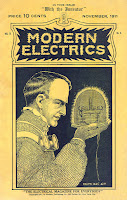One of the great pleasures of my thirty plus years of magazine collecting has been learning about many of the personalities associated with them. None is more fascinating than Hugo Gernsback. Among the dozens of magazines he published, the first was
Modern Electrics, started in 1908 and considered to be the first magazine devoted to electronics. Aside from fine technical reports, it is also notable for the publication of Gernsback's futuristic novel Ralph 124C 41+, serialized over twelve issues in 1911-12. While the writing is crude and amateurish at best, the content is the most ingenious piece of literary futurism ever published. This is not hyperbole. Some successful predictions from this novel include television (the first mention anywhere) remote-control power transmission, televised phone calls, transcontinental air service, practical solar energy (the cover of this one is just about what we predict for the future in 2008!), sound movies, synthetic foods, voice printing, synthetic fabrics and even the first description of radar, complete with a diagram!
Over the years, I've been fortunate to put together a complete run of all the "Ralph" issues, each of which features a cover illustration from the story. Here they are. I think you will be as impressed by them now as I was when I first saw them.
Later, Gernsback went on to coin the term "scientific fiction". The first issue of any magazine devoted to the genre is this 1923 issue of Gernsback's Science and Invention and the first magazine devoted wholly to the genre, Amazing Stories (here the first issue) was founded and published by Gernsback in 1926. It is a fitting tribute to this genious of futurism and publishing pioneer that today's awards for science fiction writing are known as "Hugos".
From a collector's standpoint, individual "Ralph" issues of Modern Electrics bring about a hundred dollars each in good condition if you are fortunate enough to find one. A run will take many years to put together. The first Amazing is less rare and sells for $500 and up depending on condition. The Sci-fi first usually brings about $300.
















1 comment:
As ever, great article and source material. One small correction: the last two copies of the August, 1923 Science & Invention (Scientific Fiction) sold for $1500 and $1800 on eBay. Note that these auctions ocurred before the mid-summer 2008 economic slide.
Post a Comment